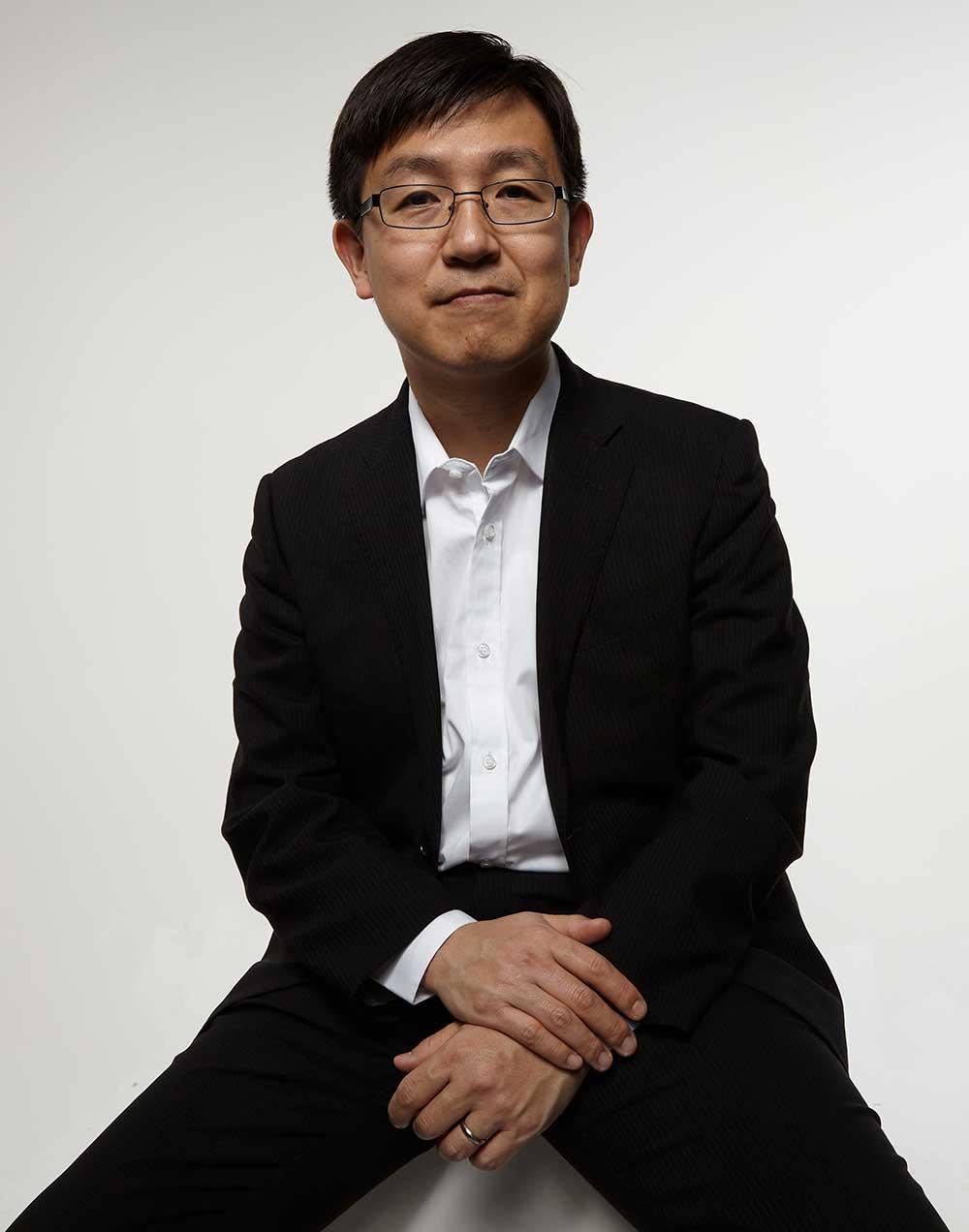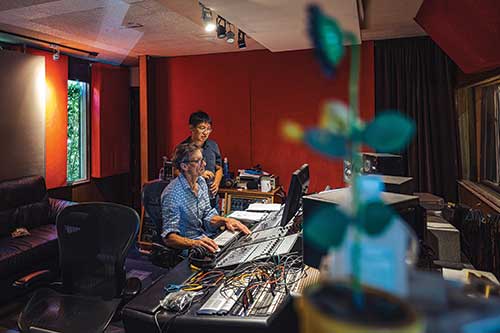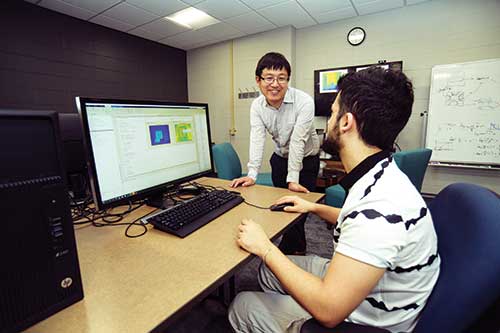In tune

Keigo Hirakawa’s life story reads like the script of a soap opera: a man consumed by two great loves, unable to choose one over the other.
The University of Dayton professor of electrical and computer engineering has achieved international renown as a researcher in the field of digital camera technology; he is also an acclaimed jazz pianist who recently released his seventh album, Pixel, featuring legendary bassist Robert Hurst.
“People who pursue dual careers do it because they can’t help it,” Hirakawa explained. “I am passionate about two things. I can’t imagine living without either one.”
He moves between these domains as fluidly as he improvises on the keyboards. Whether serving as a featured speaker at a sensor technology conference in Japan or jamming with a jazz band in Dayton, he becomes immersed in his work, joyful — acting not as if he is torn between two worlds, but as if there were no place he would rather be.
“Engineering trains me to be creative in music, and vice versa.”
“Engineering trains me to be creative in music, and vice versa,” Hirakawa said. “In both fields, you want to take chances. In both fields, you share a lot of creativity with other people while you are trying to get things done.”
Another common denominator is a gentle camaraderie, coupled with high standards, that inspires his UD students and fellow musicians alike. Hirakawa subscribes to a “work hard, play hard” philosophy that incorporates dad jokes into the classroom and invites undergraduates to create memes roasting their professor for extra credit. “It’s kindergarten math,” he quips while explaining a complicated equation — a mantra that is frequently mocked in student memes.
“You hear a lot of horror stories about students working on their Ph.D., but Keigo is a pleasure to work with,” said doctoral candidate Mitchell Grose ’21. “I don’t respond well to a boot camp environment; I respond well to passion. Keigo has high expectations, but he also is passionate about mentoring each student according to their needs.”
The same dynamic is at play whenever Hirakawa is performing. At a recent Jazz Jam with the Kelli Campbell Quartet in Dayton, he and his fellow musicians seem relaxed, spontaneous, yet keenly attuned to each other’s improvisations. Even in moments when he appears all but lost in his music, Hirakawa encourages guest musicians to come onstage, fist-bumping a saxophonist who joins them for the soul standard “Sunny.”
Bandmates know to expect the unexpected from his piano playing. “Keigo always throws out something I am not ready for,” said bass player Connor Smith. “He presses us to do more and to do more artistic things.”

Engineering colleague Vijay Asari said his friend’s musical career enhances his roles as a professor and researcher: “Music inspires the brain, and that inspiration helps you to think more creatively in other endeavors as well.”
Although they lead different labs, the two professors often bounce ideas off each other and help each other with funding proposals. During his travel abroad for research conferences, Asarai has discovered that Hirakawa is widely known for his work with sensor technology. “He is extremely brilliant in that area,” said Asari, a fellow professor of electrical and computer engineering. “If I go to Hong Kong and tell them I am from UD, they say, ‘You must be working with Keigo.’ We are very proud of having him at UD as a faculty member, as a friend and as a collaborator.”
Hirakawa feels equally honored to work side by side with his UD colleagues and students.
“From day one, the people here provided me with the resources and personal care that I needed to succeed,” he recalled. “The way that people go out of their way to help each other here has been great, and there are so many opportunities to collaborate and to work with people within the department and outside of it.”
“The way that people go out of their way to help each other here has been great...”
Hirakawa leads more than a dozen graduate students at UD’s Intelligent Signal
Systems Laboratory on the second floor of Kettering Labs. They develop algorithms, or step-by-step processes, to interpret the data coming from sensors. The better the computational instructions, the more the sensors can do.
Their work has real-world applications; Hirakawa took part in recent research that enables an ordinary camera to switch into a night vision mode, which helps automotive cameras to continue monitoring road conditions in dark environments.
In another project, he extracts a “digital fingerprint” from an image that can uniquely identify the camera it was taken with. These forensics techniques are useful for preventing tampered or falsified images from being submitted as court evidence or filed in insurance claims.
The laboratory team also has collaborated with outside companies including Sony, Samsung, Ford Motor Co., the Air Force Research Laboratory and the Japanese public broadcasting company NHK. They are currently working with Ford’s Driver Assistive Technology team, seeking to perfect devices that detect obstacles on the road.
Sarah Miller ’23 especially loved partnering with AFRL at Wright-Patterson Air Force Base.
“Our work on image enhancement is allowing the people of the Air Force to see what the different materials are and where the composites are breaking, and it can help them to better use their materials and figure out stress testing,” she said. “It’s a really great feeling to know that we are helping.”
The team-building spirit in the lab promotes productivity, Asari said: “It’s a connection you build with students, an intelligent way of solving problems. When the students get stuck, he will show them the right path to move forward.”
In the classroom, Hirakawa’s modest demeanor keeps the professor on an equal footing with his students. Even when he walks to the board to write an equation, he’s involving his students, inviting them forward and interacting with them as they work on the problem.
“He never makes you feel bad if you ask a question,” Miller said. “He lets students come into the lab at any time, so basically his office hours are 24/7.”

Hirakawa credits his “very understanding family” for making it all work, in spite of the demands of raising three school-age children. He met his wife, Wenbi Lai, when both were engineering interns for Hewitt-Packard. She’s an engineer who plays violin with the Springfield Symphony Orchestra.
“There are days when she has to skip dinner to get to a gig,” he said. “So she gets it.”
So do their children. Oldest son Mingde, 14, plays flute in the Junior Cincinnati Youth Woodwind Ensemble, while 10-year-old Dasu plays violin in the Dayton Philharmonic Junior Strings Orchestra. His twin brother, Mingsu, plays piano and accompanies his brothers in various performances.
Hirakawa wasn’t much older than his twins when he gave up music as a child. At the age of 11 — already a gifted pianist — he moved to the United States from Japan when his father’s job was transferred. He abandoned his beloved piano in favor of learning English and succeeding.
“I was stubborn,” Hirakawa said. “I didn’t want to be treated differently in school.”
Between his junior and senior years, he said he “got bit by the bug” — the jazz bug — and took up the piano again. “For a jazz musician, that was really, really late,” Hirakawa said.
So as an undergraduate at Princeton University he majored in engineering and minored in music. But he soon realized that music could never play a minor role in his life. Every night he would sneak into Princeton’s music building before it closed at midnight and practice until 2 a.m. He also made weekly commutes to New York City to take lessons with well-known jazz musicians.
Music chased after him like the Valkyries even when Hirakawa enrolled at Cornell University in 2000 to pursue his doctorate in electrical engineering. The music director had given three weeks’ notice and the program was in chaos; Hirakawa served as acting director of the Cornell University Jazz Ensembles from 2000 to 2001, welcoming many jazz greats to the stage as guest soloists.
Around the same time he was taking part in Cornell’s pioneering research for a process known as “demosaicking,” that would enable any digital camera to produce a full-color image from a single sensor. His method removed false colors, or colors that are not supposed to be present in the scene, a common problem in cameras at the time.
“For the first time, we achieved a level of image quality people didn’t think we could achieve.”
“For the first time, we achieved a level of image quality people didn’t think we could achieve,” Hirakawa recalled. “It was exactly what the camera engineers needed at the time, and it became widely adopted in the industry.”
In the midst of this research, Hirakawa found once again that he couldn’t help himself — he started applying to music schools, and he was accepted into the New England Conservatory of Music master’s degree program in jazz performance.
Instead of feeling drained by these disparate ambitions, Hirakawa became more energized, a pattern that would repeat itself throughout his career. He experienced a surge of productivity in his research as he was leaving Cornell. And he completed his dissertation for his Cornell doctorate during the first year of his master’s program at the conservatory. “I have the weirdest résumé of all time,” he said.
Hirakawa grew up in the Akron area and vowed, after graduating from high school, “I am done with Ohio and not coming back here.”
When the opportunity arose to teach at UD, however, he was immediately impressed.
“The first thing that I noticed was that the students here are treated really well, and the campus emphasizes the notion of community,” he said. “I thought to myself, ‘Oh, my gosh, what’s going on? Students aren’t supposed to be this happy.’”
It’s a tradition Hirakawa has done his best to uphold, even while teaching very challenging courses. He tells his students, “This is a hard class, but we are in it together.”
He also connects with the students who work in his lab to create a bond that benefits them all. He conducts weekly lab meetings, hosts occasional potluck dinners and encourages student researchers to attend one another’s milestone presentations.
“I am here to struggle with them,” he said. “It’s a process of mentoring, of identifying the strengths and weaknesses of each student and figuring out how to get the best use out of their strength. Once they hit their stride, they come along very well. By the end of their Ph.D. program, they are teaching me stuff.”
As a result of the practical skills honed during her laboratory research, Miller landed a job as a signal and image processing engineer after earning her doctorate in May. It’s one of many examples, she said, of Hirakawa’s impact on the future of engineering.
“Keigo really cares about the students in his classroom and in the lab, and he works incredibly hard to accomplish all things he is able to do,” she said. “Both industry and the research community will benefit from all the research he has done and the students he has taught.”
Hirakawa also is leaving his mark on the world of jazz. Jazz pianist Stephen Scott described his work as “full of inventiveness and a sense of adventure, creativeness and voracious angularity, aggressiveness, and jaggedness, passion and swing.”
He performs at jazz clubs and jazz festivals throughout the Midwest with his own Keigo Hirakawa Trio and has worked with a number of jazz legends such as Donald Byrd and Joe Lovano. As a member of a half dozen jazz, funk and Latin bands — such as the Mike Wade Jazz Mafia, Eddie Brookshire Quintet, Connor Smith Jazz Trio and Kelli Campbell Quartet — he maintains a busy performance schedule.
“He has one of the best pedigrees of any pianist around here. That’s why I sought him out.”
“He has one of the best pedigrees of any pianist around here,” Smith explained. “That’s why I sought him out. It’s important to play with great players because you are always learning and exploring. It helps me to push myself.”
Origin Records, an independent jazz label, released his latest album, Pixel, in June. Appearing on this album is Robert Hurst, a jazz bassist who has performed on seven Grammy-winning records.
“I grew up listening to Bob,” Hirakawa said. “He is a magician on the bass, so I had to bring my ‘A’ game. Bob is known for his unique style of playing, so I put together musicians who explore their own sounds. We all took chances, and the album came out great because of that. Those strong personalities all came through.”
The album’s title is no coincidence — a simple word that captures the essence of his musical and scientific careers.
“In music there are only 12 notes, yet there are so many ways to combine them to make music,” Hirakawa said. “There are moments when you play with really top-notch musicians, moments when we all try something and something really magical happens. Photography is like that, a series of numbers that collectively make up an image, and yet those pixels can evoke so many different results and emotions.”
On paper, Hirakawa’s life seems like a statistical impossibility. Yet whether he is working with his students in the laboratory or playing the piano at a jazz club, the same look of contentment steals over his face, like a man whose life is perfectly in tune.
Mary McCarty is a longtime Dayton-area journalist who has worked as a columnist and investigative reporter for the Dayton Daily News and as a senior editor for Cincinnati Magazine.